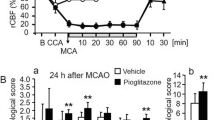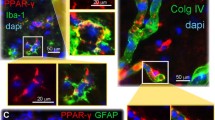Abstract
Our early experiments confirmed that rosiglitazone (RSG), a peroxisome proliferator-activated receptor γ (PPARγ) agonist, had therapeutic potential for the treatment of diffuse axonal injury (DAI) by inhibiting the expression of amyloid-beta precursor protein and reducing the loss and abnormal phosphorylation of tau, but the underlying mechanisms were not fully defined. In this study, we aimed to investigate a possible role for PPARγ in the protection of blood–brain barrier (BBB) integrity in a rat model of DAI, and the underlying mechanisms. PPAR agonists and antagonists were intraperitoneally injected after DAI. Treatment with RSG ameliorated axonal injury, cell apoptosis, glia activation, and the release of inflammatory factors such as TNF-α, IL-1β, and IL-6. It also increased the expression of tight junction-associated proteins like ZO-1, claudin-5, and occludin-1, whereas the PPARγ antagonist GW9662 had the opposite effects. These effects were also studied in a BBB in vitro model, consisting of a monolayer of human microvascular endothelial cells (HBMECs) subjected to oxygen and glucose deprivation (OGD). Treatment with RSG ameliorated the loss of BBB integrity and the increased permeability induced by OGD by reducing the release of inflammatory factors and maintaining the expression of tight junction-associated proteins. Interestingly, caveolin-1 was found located mainly in endothelial cells, and RSG increased the expression of caveolin-1, which decreased following OGD. In contrast, caveolin-1 siRNA abrogated the protective effects of RSG in the in vitro BBB model. In conclusion, we provide evidence that PPARγ plays an important role in a series of processes associated with DAI, and that the PPARγ agonist RSG can protect BBB integrity by decreasing the levels of inflammatory mediators through a caveolin-1-dependent pathway.









Similar content being viewed by others
References
Blanchette, M., and R. Daneman. 2015. Formation and maintenance of the BBB. Mechanisms of Development 138 (Pt 1): 8–16.
Coisne, C., and B. Engelhardt. 2011. Tight junctions in brain barriers during central nervous system inflammation. Antioxidants & Redox Signaling 15 (5): 1285–1303.
Fakhoury, M. 2015. Role of immunity and inflammation in the pathophysiology of neurodegenerative diseases. Neurodegenerative Diseases 15 (2): 63–69.
Liu, H., M.E. Rose, S. Culver, X. Ma, C.E. Dixon, and S.H. Graham. 2016. Rosiglitazone attenuates inflammation and CA3 neuronal loss following traumatic brain injury in rats. Biochemical and Biophysical Research Communications 472 (4): 648–655.
Yao, J., K. Zheng, and X. Zhang. 2015. Rosiglitazone exerts neuroprotective effects via the suppression of neuronal autophagy and apoptosis in the cortex following traumatic brain injury. Molecular Medicine Reports 12 (5): 6591–6597.
Zhao, Yong-Lin, Jin-Ning Song, et al. 2016. Rosiglitazone ameliorates diffuse axonal injury by reducing loss of tau and up-regulating caveolin-1 expression. Neural Regeneration Research 11 (6): 944–950.
Zhao, Y.L., J.N. Song, and M. Zhang. 2014. Role of caveolin-1 in the biology of the blood-brain barrier. Reviews in the Neurosciences 25 (2): 247–254.
Mandrekar-Colucci, S., A. Sauerbeck, P.G. Popovich, and D. McTigue. 2013. PPAR agonists as therapeutics for CNS trauma and neurological diseases. ASN Neuro 5 (5): e00129–e00129.
Llaverias, G., M. Vázquez-Carrera, R.M. Sánchez, et al. 2004. Rosiglitazone upregulates caveolin-1 expression in THP-1 cells through a PPAR-dependent mechanism. Journal of Lipid Research 45 (11): 2015–2024.
Zhao, Y., J. Zhao, M. Zhang, et al. 2017. Involvement of toll like receptor 2 signaling in secondary injury during experimental diffuse axonal injury in rats. Mediators of Inflammation 1570917: 2017.
Ramirez, S.H., D. Heilman, B. Morsey, R. Potula, J. Haorah, and Y. Persidsky. 2008. Activation of peroxisome proliferator-activated receptor gamma (PPARγ) suppresses Rho GTPases in human brain microvascular endothelial cells and inhibits adhesion and transendothelial migration of HIV-1 infected monocytes. Journal of Immunology 180 (3): 1854–1865.
Lombardi, A., G. Cantini, E. Piscitelli, S. Gelmini, M. Francalanci, T. Mello, E. Ceni, G. Varano, G. Forti, M. Rotondi, A. Galli, M. Serio, and M. Luconi. 2008. A new mechanism involving ERK contributes to rosiglitazone inhibition of tumor necrosis factor-alpha and interferon-gamma inflammatory effects in human endothelial cells. Arteriosclerosis, Thrombosis, and Vascular Biology 28 (4): 718–724.
Jin, X., Y. Sun, J. Xu, and W. Liu. 2015. Caveolin-1 mediates tissue plasminogen activator-induced MMP-9 upregulation in cultured brain microvascular endothelial cells. Journal of Neurochemistry 132 (6): 724–730.
Gu, Y., G. Zheng, M. Xu, Y. Li, X. Chen, W. Zhu, Y. Tong, S.K. Chung, K.J. Liu, and J. Shen. 2012. Caveolin-1 regulates nitric oxide-mediated matrix metalloproteinases activity and blood-brain barrier permeability in focal cerebral ischemia and reperfusion injury. Journal of Neurochemistry 120 (1): 147–156.
Ye, L.B., X.C. Yu, Q.H. Xia, Y. Yang, D.Q. Chen, F. Wu, X.J. Wei, X. Zhang, B.B. Zheng, X.B. Fu, H.Z. Xu, X.K. Li, J. Xiao, and H.Y. Zhang. 2016. Regulation of caveolin-1 and junction proteins by bFGF contributes to the integrity of blood-spinal cord barrier and functional recovery. Neurotherapeutics 13 (4): 844–858.
Long, M., S.H. Huang, C.H. Wu, G.M. Shackleford, and A. Jong. 2012. Lipid raft/caveolae signaling is required for Cryptococcus neoformans invasion into human brain microvascular endothelial cells. Journal of Biomedical Science 19: 19.
Dong, H.J., C.Z. Shang, D.W. Peng, J. Xu, P.X. Xu, L. Zhan, and P. Wang. 2014. Curcumin attenuates ischemia-like injury induced IL-1beta elevation in brain microvascular endothelial cells via inhibiting MAPK pathways and nuclear factor-kappaB activation. Neurological Sciences 35 (9): 1387–1392.
Yang, F., S. Liu, C. Yu, S.J. Wang, A. Paganini-Hill, and M.J. Fisher. 2012. PDE4 regulates tissue plasminogen activator expression of human brain microvascular endothelial cells. Thrombosis Research 129 (6): 750–753.
Miao, Z., Y. Dong, W. Fang, D. Shang, D. Liu, K. Zhang, B. Li, and Y.H. Chen. 2014. VEGF increases paracellular permeability in brain endothelial cells via upregulation of EphA2. The Anatomical Record (Hoboken) 297 (5): 964–972.
Zhou, J.X., G.R. Ding, J. Zhang, Y.C. Zhou, Y.J. Zhang, and G.Z. Guo. 2013. Detrimental effect of electromagnetic pulse exposure on permeability of in vitro blood-brain-barrier model. Biomedical and Environmental Sciences 26 (2): 128–137.
Lin, M.N., D.S. Shang, W. Sun, B. Li, X. Xu, W.G. Fang, W.D. Zhao, L. Cao, and Y.H. Chen. 2013. Involvement of PI3K and ROCK signaling pathways in migration of bone marrow-derived mesenchymal stem cells through human brain microvascular endothelial cell monolayers. Brain Research 1513: 1–8.
Soslow, R.A., A.J. Dannenberg, D. Rush, et al. 2015. COX-2 is expressed in human pulmonary, colonic, and mammary tumors. Cancer 89 (12): 2637–2645.
Liu, M., A.D. Bachstetter, W.A. Cass, J. Lifshitz, and G. Bing. 2017. Pioglitazone attenuates Neuroinflammation and promotes dopaminergic neuronal survival in the nigrostriatal system of rats after diffuse brain injury. Journal of Neurotrauma 34 (2): 414–422.
Sauerbeck, A., J. Gao, R. Readnower, M. Liu, J.R. Pauly, G. Bing, and P.G. Sullivan. 2011. Pioglitazone attenuates mitochondrial dysfunction, cognitive impairment, cortical tissue loss, and inflammation following traumatic brain injury. Experimental Neurology 227 (1): 128–135.
Cunningham, T.L., Cartagena, C.M., Lu, X.-C., et al. 2013. Correlations between blood-brain barrier disruption and neuroinflammation in an experimental model of penetrating ballistic-like brain injury.
Mayhan, W.G. 2002. Cellular mechanisms by which tumor necrosis factor-alpha produces disruption of the blood-brain barrier. Brain Research 927 (2): 144–152.
Mankertz, J., S. Tavalali, H. Schmitz, et al. 2000. Expression from the human occludin promoter is affected by tumor necrosis factor alpha and interferon gamma. Journal of Cell Science 113 (Pt 11): 2085–2090.
McColl, B.W., N.J. Rothwell, and S.M. Allan. 2008. Systemic inflammation alters the kinetics of cerebrovascular tight junction disruption after experimental stroke in mice. The Journal of Neuroscience 28 (38): 9451–9462.
Sozen, T., R. Tsuchiyama, Y. Hasegawa, H. Suzuki, V. Jadhav, S. Nishizawa, and J.H. Zhang. 2009. Role of interleukin-1beta in early brain injury after subarachnoid hemorrhage in mice. Stroke 40 (7): 2519–2525.
Uchida, T., M. Mori, A. Uzawa, H. Masuda, M. Muto, R. Ohtani, and S. Kuwabara. 2017. Increased cerebrospinal fluid metalloproteinase-2 and interleukin-6 are associated with albumin quotient in neuromyelitis optica: Their possible role on blood-brain barrier disruption. Multiple Sclerosis 23 (8): 1072–1084.
Takeda, S., N. Sato, K. Ikimura, H. Nishino, H. Rakugi, and R. Morishita. 2013. Increased blood-brain barrier vulnerability to systemic inflammation in an Alzheimer disease mouse model. Neurobiology of Aging 34 (8): 2064–2070.
Farbood, Y., A. Sarkaki, M. Dianat, A. Khodadadi, M.K. Haddad, and S. Mashhadizadeh. 2015. Ellagic acid prevents cognitive and hippocampal long-term potentiation deficits and brain inflammation in rat with traumatic brain injury. Life Sciences 124: 120–127.
Gu, Y., C.M. Dee, and J. Shen. 2011. Interaction of free radicals, matrix metalloproteinases and caveolin-1 impacts blood-brain barrier permeability. Frontiers in Bioscience (Scholar Edition) 3: 1216–1231.
Delerive, P., F. Martin-Nizard, G. Chinetti, et al. 1999. Peroxisome proliferator-activated receptor activators inhibit thrombin-induced endothelin-1 production in human vascular endothelial cells by inhibiting the activator protein-1 signaling pathway. Circulation Research 85 (5): 394–402.
Burgermeister, E., L. Tencer, and M. Liscovitch. 2003. Peroxisome proliferator-activated receptor-gamma upregulates caveolin-1 and caveolin-2 expression in human carcinoma cells. Oncogene 22 (25): 3888–3900.
Hu, Q., X.J. Zhang, C.X. Liu, X.P. Wang, and Y. Zhang. 2010. PPARgamma1-induced caveolin-1 enhances cholesterol efflux and attenuates atherosclerosis in apolipoprotein E-deficient mice. Journal of Vascular Research 47 (1): 69–79.
Werion, A., V. Joris, M. Hepp, L. Papasokrati, L. Marique, C. de Ville de Goyet, V. van Regemorter, M. Mourad, B. Lengelé, C. Daumerie, E. Marbaix, S. Brichard, M.C. Many, and J. Craps. 2016. Pioglitazone, a PPARgamma agonist, upregulates the expression of caveolin-1 and catalase, essential for thyroid cell homeostasis: a clue to the pathogenesis of Hashimoto's thyroiditis. Thyroid 26 (9): 1320–1331.
Yang, K., W. Lu, Q. Jiang, X. Yun, M. Zhao, H. Jiang, and J. Wang. 2015. Peroxisome proliferator-activated receptor gamma-mediated inhibition on hypoxia-triggered store-operated calcium entry. A caveolin-1-dependent mechanism. American Journal of Respiratory Cell and Molecular Biology 53 (6): 882–892.
Funding
This work was financially supported by the Natural Science Foundation of Shaanxi Province (Grant No. 2018JQ8063) to Jie Qin.
Author information
Authors and Affiliations
Contributions
Yonglin Zhao designed the concept of the work and the experiments, did the experiments, and wrote the manuscript. Jin Qin and Jinning Song contributed to the initial idea and conceived the study design. Ming Zhang and Tingqin Huang helped draft and revise the manuscript. Xing Wei performed the analyses and designed the figures. All authors approved the manuscript.
Corresponding author
Ethics declarations
All procedures were performed according to the Guidelines and Suggestions for the Care and Use of Laboratory Animals formulated by the Ministry of Science and Technology of the People’s Republic of China (PRC) and the Guidelines for the Care and Use of Laboratory Animals from the National Institutes of Health (NIH Publication no. 80-23). The Biomedical Ethics Committee for Animal Experiments of Shaanxi Province (China) approved this study.
Conflict of Interest
The authors declare that there is no personal or institutional conflict of interest related to the presented research and its publication.
Rights and permissions
About this article
Cite this article
Zhao, Y., Wei, X., Song, J. et al. Peroxisome Proliferator-Activated Receptor γ Agonist Rosiglitazone Protects Blood–Brain Barrier Integrity Following Diffuse Axonal Injury by Decreasing the Levels of Inflammatory Mediators Through a Caveolin-1-Dependent Pathway. Inflammation 42, 841–856 (2019). https://doi.org/10.1007/s10753-018-0940-2
Published:
Issue Date:
DOI: https://doi.org/10.1007/s10753-018-0940-2




